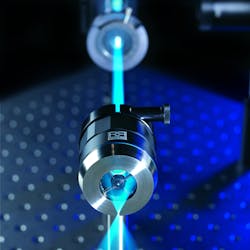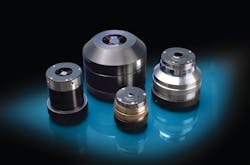NICHOLAS JAMES
Traditional optical system design depends on the refractive properties of lenses, but for applications requiring multispectral operation across a wide range of laser wavelengths, a lens-based system can present significant drawbacks. Reflective optical systems, however, can provide a less complex and lower-cost option for handling high power with operation across a broad wavelength spectrum.
Refractive lens design faces two major challenges when applied to laser focusing and multispectral imaging applications. One is dispersion, a characteristic of virtually every medium, where the speed of light passing through the lens is wavelength dependent. Dispersion prevents different wavelengths of light from coming to focus at the same location. Compound lenses address this problem with the various elements made from a selected balance of multiple materials, each having differing optical characteristics so as to negate each other's dispersion.
This approach only works over a limited spectral band, however, typically within specific regions such as visible, near-infrared (NIR), short-wave IR (SWIR), and so on. The larger the band, or the more corrected the system needs to be, the more elements are required. Aside from the consequent time and cost constraints of such a complex approach, a refractive system has inherent limits in its optical transmission range due to the chemistry of the lens materials and the number of lenses involved.
This leads to the second drawback of a refractive system: absorption. In high-power laser focusing systems, if even a small percentage of the optical energy gets absorbed, the lens can undergo catastrophic failure. The traditional solution has been to select lens materials and choose coatings to maximize transmission at the laser wavelength.
Unfortunately, these two solutions don't complement each other when both multispectral operation and high laser power are needed. In refractive systems, as the waveband becomes larger, the ability to maintain extremely high transmission in the antireflective coatings is greatly diminished. So a traditional lens system can be made for limited multispectral operation or to handle high laser power, but not both simultaneously.
Multiple lenses required
An application that highlights the potential cost of this dilemma is inspection and repair of flat-panel displays during manufacturing. Visible light is scanned across the flat-panel surface to find imperfections and defects and once a defect has been identified, a high-power laser–typically a 1064 nm Nd:YAG–ablates the defect. For a single optical system to serve this application, it would have to be highly transmissive in both the IR and in the visible spectrum. Further, the system would have to focus both the IR and visible light in the same plane to enable defects to be reliably targeted with the laser.
Such a complex and demanding lens system would be prohibitively expensive, even if it were possible to find materials capable of transmission over such a broad spectrum. The solutions that have been implemented, therefore, use two sets of compound objective lenses. The first is for the visible-light scanning operation, often incorporating a HeNe laser spot projected through the system for alignment purposes. When the HeNe laser spot is aligned over the defect, a motorized turret on which the lens systems are mounted rotates the visible-light objective out of the optical path and replaces it with an NIR objective to handle the laser ablation.
Even this approach is costly because of the multiple, multilens objectives and motorized turret, and it is expensive to maintain. The NIR objective does not focus in the same plane as the visible-light objective, so alignment in the system is critical to ensuring that only the defect is ablated by the laser.
A reflective optical system can address this application with only a few optical elements because a reflecting system is essentially wavelength independent. Reflection does not induce dispersion; focus depends solely on geometry so there is no need for multielement corrections. The optical throughput of the system–which depends on mirror reflectivity–will be wavelength dependent, but that dependency is weak. Reflective metallic coatings are available that have spectral ranges of 10 μm, 20 μm, and beyond; they allow a mirror to handle wavelengths from the deep-UV (150 nm) up past the LWIR (20 μm). If ultrahigh-reflectivity is needed to avoid thermal build-up from high laser power, the mirror can include specific laser coatings to optimize throughput at that wavelength without significantly affecting the system's performance over the remaining spectrum.
A typical reflective system has only a few components: a primary mirror to provide the focus, a secondary mirror to divert the light path along a more convenient direction, a "spider" support to hold the secondary mirror, and a tube to hold the entire optical assembly (see Fig. 1). And because these systems are optically simple they can be implemented at a lower cost than reflective systems. Furthermore, they can be made lightweight and rugged, able to survive drops of considerable distances without damage or need for realignment. They can also be made more compact because mirrors redirect the optical axis of the system after each reflection.
In the flat-panel inspection and repair system example, the advantages of reflective system design are compelling. Only one objective is needed instead of two, eliminating the motorized component and reducing system size. Motor elimination lowers both system and operating costs and it improves productivity because the objectives do not have to be switched, thus speeding throughput. The simplified optical design also means that the system becomes easier to modify if needed. These benefits combine to offer a significantly higher return on investment than a refractive system.
Design considerations
Reflective optical systems can be easier than refractive ones to design and implement in multispectral applications; however, there are considerations that must be taken into account when specifying reflecting objectives. The first is which style–fixed or adjustable–is to be used. A fixed objective will be factory adjusted to its ideal maximum performance configuration and will remain fixed over time. This makes for a robust unit that does not need continual recalibration because of vibration and accidental maladjustment (see Fig. 2). Further, because a fixed-style objective is secured in place, it is generally more rugged than an adjustable unit, even able to survive drops and falls from moderate distances.Fixed objectives are generally best for industrial applications with harsh operating conditions when the setup does not need to be changed over time. To specify the objective, the developer must know the conjugate distance needed–either infinite or set to a specific tube length–and the cover glass thickness (if any) at the time of order. Once fabricated, there is no option for making adjustments to the objective in the future.
An adjustable reflecting objective is typically one that is changeable in one or both of two ways: Either the tube length is adjustable or the correction for eliminating spherical aberration due to the cover glass can be varied (see Fig. 3). Usually the only thing that actually changes within the objective itself, however, is the spacing between the primary and secondary mirrors. Vendors often set adjustable objectives for optimal performance before shipping them but should include realignment instructions and any special parts required, such as an alignment slide. The user can then set the unit up on a system, dial in the exact tube length needed as well as the cover glass correction, then simply realign the unit and secure it in place.While the adjustable style will need to be readjusted periodically, it enables a more versatile design that can operate in multiple configurations. An adjustable off-the-shelf objective, for instance, can easily be used with less-than-typical tube lengths and cover glass thicknesses, meeting a unique need without the additional cost of a custom objective.
Whether fixed or adjustable, there are additional points to consider when purchasing a reflective-type objective. Key is the obscuration size of the secondary mirror and the spider legs holding it on. The presence of the secondary mirror in the primary optical path will inevitably block some of the beam/image going through the system, which leads to a decrease in the delivered energy and can degrade the beam quality. The spider legs can cause diffraction effects, especially in designs with four straight spider legs. The symmetry of four straight legs can cause individual leg diffraction effects to reinforce one another. A design with three curved spider legs will help, with the curve spreading the diffraction effects more evenly and thereby negating energy nonuniformities due to diffraction.
Another consideration when using reflecting objectives with lasers is the laser power. Reflective objectives typically come standard with basic metallic coatings–suitable for many applications but not always the right choice with high-output lasers. For higher power levels, laser coated versions of the objective are available that can meet the required damage threshold. Depending on the objective type, this can be very easily customized.
The capabilities of reflective objectives are applicable to many tasks. Laser annealing or drilling, for instance, can readily combine visible light targeting with IR power delivery. Thin-film measurement systems can operate with probe wavelengths from 190 nm to 1 μm using a single set of optics. And imaging systems can operate over any wavelength range for which sensors are available without changing optics.
Nicholas James is a product line manager at Edmund Optics, 101 E. Gloucester Pike, Barrington, NJ 08007-1380; e-mail: [email protected]; www.edmundoptics.com.

